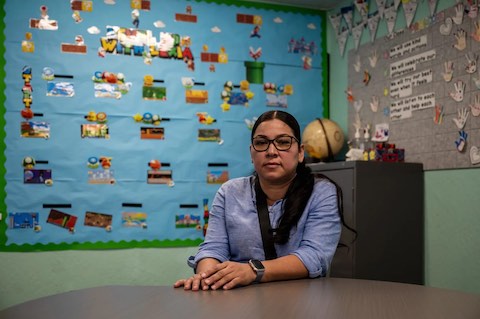
06 Feb A Shortage of Bilingual Educators Leaves English Learners With Too Few Qualified Teachers

Miguel Alvarado, a father of two, is the president of the English Learner Advisory Committees at his daughters’ schools.
Story by Ximena Loeza, El Tímpano | Photos by Hiram Alejandro Durán for El Tímpano / Catchlight / Report for America corps member
Miguel Alvarado and his wife instilled in their two daughters that an education will put their dreams within reach. Alvarado was so committed to the idea that he moved his family from Mexico City to Bay Point to secure a better education for his children.
They learned with dismay that teachers and staff at his daughters’ school might not share their perspectives on education. His 16-year-old daughter, Ariadna, dreams of studying marine biology after graduating from Pittsburg High School. Her fascination with the ocean and its inhabitants pushes her to excel in school and get good grades, Alvarado said. But when she expressed her interest in studying oceans in college, a counselor at her school, Ariadna told her parents, discouraged her and said it was impossible for people like her with few family resources.
“We support our daughter, and we tell her not to pay attention to those comments. Those people are just bigoted,” said Alvarado in Spanish. “But there are many children who do not have support from their parents because their parents are busy working all day to get money, to pay the rent and to pay for food for those children.”
These encounters and others with the Pittsburg Unified School District pushed Alvarado to become president of the English Learner Advisory Committee at his daughters’ schools. Alvarado links what happened with his daughter to the teacher shortages at East Contra Costa County school districts and the painful lack of Spanish-speaking and Latino educators in particular. Alvarado and his family found that those shortages affect English-language learners and monolingual Spanish-speaking parents alike.
Misassignments—the placement of an employee in an educational position or course for which they don’t hold a legally recognized certificate, credential, permit or waiver—are used to make up shortfalls in Contra Costa County. During the 2020-2021 school year, the most recent data available, there were more than 970 misassigned educators and more than 2,300 misassigned courses, according to data from the California Teaching Commission. Roughly 27% of English language development positions were unfilled in the 2020-21 school year, the second highest type of teacher vacancy in the state.
During the same period, the Pittsburg Unified School District had 12 misassigned educators and 52 misassigned courses. Twenty-five percent of those misassignments were in English Language Development.
A misassigned educator or class might mean long-term substitutes filling in for teachers, an educator who is still finishing their certifications or an educator filling a role they do not have certification for, like a history teacher teaching a science class.
When Mirna Mayorquin and her family, including her daughter, Joanna, moved to Contra Costa County from Washington state in 2020, they hoped for better schools and increased language access for Spanish speakers. Joanna was starting her senior year at a brand-new school, Liberty Union High School, and had dreams of becoming an educator.
- Mirna Mayorquin at Brentwood Village Community Resource Center.
“It’s heartbreaking,” Mayorquin said in Spanish as she sat in the Brentwood Village Community Resource Center, where she works with ELAC in Byron. She said that students who don’t speak English can’t get their basic needs met. “Imagine if they need something as simple as using the bathroom but can’t communicate it. They don’t understand anything.”
Mayorquin started working for the community center a few years after she moved to Byron and has participated in ELAC for five years. She said she decided to work with ELAC parents because of her experience with her own children in the Contra Costa school system.
Mayorquin’s youngest daughter, Juliana, is eight years old and is currently in third grade at Discovery Bay Elementary School outside Brentwood. Her daughter was raised bilingual in both English and Spanish. In her class, four students are English learners who are monolingual in Spanish. But, their teacher is not bilingual and struggles to communicate and teach these children. The teacher relies on the bilingual students, including Juliana, to help the English learner students, Mayorquin said. She adds that she has noticed how this extra workload is affecting her daughter’s education.
“That’s a big problem for me, that the teacher doesn’t speak any Spanish, so the students have to help each other. These students ask, ‘What is the teacher saying? Can you help me?’ And for me, as a parent, that’s not right, this shouldn’t be happening,” said Mayorquin. “They’re little, it’s not fair to them, especially for these children who come from another country.”
Across California, the gap between bilingual teacher authorizations and the growing number of bilingual students is stark. Between the 2012 and 2022 school years, about 7,500 bilingual authorizations were issued to teachers, according to the California Budget and Policy Center. Meanwhile, more than 1.8 million students lived in homes where Spanish was spoken.
According to the California Teaching Commission, in 2022-23, approximately 4.4% of the total teaching staff in California public schools held interim credentials, permits or waivers. These temporary authorizations enable educators to teach in California public schools while completing the requirements for full teaching credentials. A temporary authorization doesn’t necessarily result in a permanent teacher down the road, as high teacher turnover rates suggest.
Kai Mathews is the Research Director of the California Educator Diversity Project at UCLA’s Center for the Transformation of Schools. Mathews’ research focuses on the state of California and its efforts, policies and practices to retain and support educators of color entering the teacher pipeline. She identified teacher burnout as one culprit behind low retention and high vacancy rates across the state. Others include low pay, the rising costs of living and lack of competitive benefits and incentives. Bilingual and English teachers face additional obstacles, she added.
“Number one, there are not a lot of services for them to become authorized, and if there are, it’s an extra fee. There have been efforts to financially support bilingual and (English-language) teachers, but they’re not consistent, and they’re very hard and difficult to navigate sometimes,” Mathews said.
Without a properly authorized, specialized teacher for these students, their quality of education diminishes. “They’re essentially getting left behind. They are not getting the support or the curriculum or the classes that they need in a timely fashion,” said Matthews. “They don’t have the actual appropriate classes, and they don’t have the staff to do the testing that the student needs to take to reclassify them. And then some of them are hanging around at the lowest level of their entire school.”
The emotional effects of linguistic isolation at school make learning even more challenging, Matthews added. “The sense of not having anyone there that can resonate with you on a cultural and racial level… is also impacting the ways that students get to show up. They don’t get to feel like they’re part of the community.”
At Pittsburg Unified, where 26% of students are English learners and 64% are Latino, language barriers make it difficult for families to advocate for themselves.
Cameron Attaran is the Assistant Principal and an administrator for the English Language Development (ELD) program at Pittsburg High School. He has been working in education in Contra Costa County for more than four years, and has built a unique relationship with the English learner students at the high school. He is dedicated to creating a productive and safe learning environment and “home base” for the English learner students and especially for newcomer students, he said, though he recognizes that the school has a long way to go.
“There’s sometimes culture shock and a feeling of like, wow, this is a really big place. So, we make a deliberate effort to show them that we can be a home base, that they can come here and can get fed. We want them to have a sense of belonging and people they can trust when they come here,” said Attaran.
Alvarado said his community’s concerns are often ignored or dismissed. There are several obstacles English learner families have to cross to have a chance of being heard in a forum like ELAC, said Alvarado, including language barriers, the inconvenience of ELAC meeting times or a lack of action from school administrators. The ELAC meetings he leads have dwindled to only three parents, and that includes him and his wife. During the pandemic they met over Zoom and had over a dozen parents attending. These factors and others discourage families from participating in public meetings, he added.
“There are many parents who are not here because nothing happens when they speak up. Because they say, ‘Nothing changes, why would I come?’ It discourages them because nothing happens. It feels as though we are not important enough,” he said.
The pressure of these shortages is felt acutely by current teachers. Celia Medina-Owens, an elementary school teacher and president of the Pittsburg Education Association, the Pittsburg teacher’s union, has worked in education in Contra Costa County for 20 years. She said that educators are increasingly expected to take on additional roles, including filling in for absent teachers. This extra workload fuels the burnout teachers are experiencing, increasing teacher shortages.
“We’re being asked to provide emotional and mental health support without the necessary training or resources,” Medina-Owens said. “This added stress has led many seasoned educators to leave the field, exacerbating the shortage.”
Lynn Mackey is the Contra Costa Superintendent of Schools and a lifelong county resident. Mackey said that she recognizes teachers’ hard work and dedication for their students and their profession, but also how common burnout is.
“We ask teachers and educators in general to do so much more. It’s almost like we ask teachers to be everything to everybody, right? We’re taking care of their social and emotional welfare, which schools have always done to some extent, but in comparison to post-pandemic, there’s a lot more pressure on teachers and especially here in California,” she said.
The county focuses on supporting new teachers through a teacher orientation program to prevent burnout and encourage them to remain in the profession. The county also partners with local high schools to offer internships and classroom experiences through a Regional Occupational Program to cultivate a future generation of educators.
“We’re trying to really listen to the frustrations,” Mackey said, “because it is super frustrating if you’re a parent and your children don’t have a qualified teacher in the classroom.”
In addition to running the ELAC programs at his daughters’ schools, Alvarado currently works as a handyman and volunteers in service of day laborers in Contra Costa County. He said he hopes to show his children the importance of standing up for their beliefs and advocating for their communities. His eldest daughter, Ariadna, is now in student leadership at her high school.
“It’s very important to me that my daughters get the fullest experience from public schools, even with the obstacles that we face, we have to keep fighting. We have to break the chains tied to us and change the future of our families,” Alvarado said.





No Comments